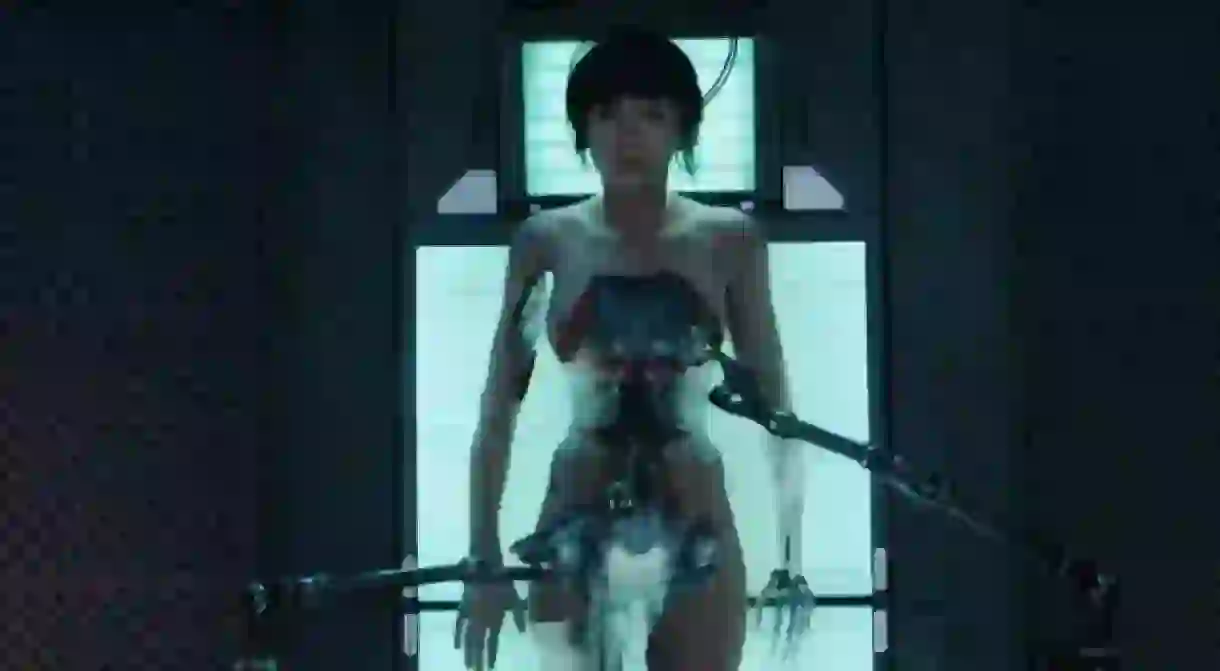Scarlett Adopts Au Naturel Look for 'Ghost in the Shell' Super Bowl Spot

Featuring Scarlett Johansson in a nude bodysuit and a mecha (robot) geisha, the Super Bowl spot for the live-action manga movie Ghost in the Shell is fierce, flashy, and politically incorrect.
Paramount’s March 31 release, based on Mamoru Oshii’s philosophy-weighted and hugely influential 1995 anime, stars Johansson as a curvy cyborg counterterrorist commander. She sports a flapper’s shiny black bob (straighter than Louise Brooks’s ‘do) and has a preference for fighting au naturel.
She also gets wet a lot, or so it seems from the the 30-second spot that’s showing in the commercial breaks during this Sunday’s Super Bowl (below).
Sure to be a talking point, especially if the game between the New England Patrons and the Atlanta Falcons proves lackluster, the spot shows Johansson’s Major Motoko Kusanagi plummeting backwards from a tower, bursting through a glass wall, and beating up various foes in a futuristic Tokyo. The Major and her squad are tasked with defeating a cadre of hackers and A.I. saboteurs.
Customized as a potentially huge franchise for Johansson, 2016’s top-grossing actor worldwide, the Major cunningly blends aspects of the star’s Avengers character Black Widow and her mysterious alien in Under the Skin. The faux nudity won’t deter manga fanboys and their dads from flocking to the sci-fi movie.
“We’re not actually trying to pretend she’s naked,” producer Avi Arad told the video games website IGN. “The suit emulates some of the ideas of the panel lines. When you see it in the movie, you’re not meant to think that she’s naked.” Yeah, right.

Directed by Rupert Sanders (the Englishman who clad Kristin Stewart in armor for Snow White and the Huntsman), Ghost in the Shell has already generated criticism for the “white-washing” inherent in casting Johansson as Kusanagi.
Paramount and its producing partner DreamWorks conducted brief CGI experiments to “Asian-ize” one character’s look in the film, though Paramount denied that Johansson’s face was the object of these tests.
Sam Yoshiba, director of the international business division at Kodansha (the Tokyo company that holds the rights to Ghost in the Shell) told the Hollywood Reporter, “Looking at her career so far, I think Scarlett Johansson is well cast. She has the cyberpunk feel. And we never imagined it would be a Japanese actress in the first place.” Mamoru Oshii has also endorsed Johansson’s casting.

The Ghost in the Shell spot features two shots of a mecha geisha, one of the Major’s adversaries. This character is played not by a Japanese actress, but by Jacqueline Lee Guerts, a white actress from New Zealand, where the movie was shot.
The first mecha geisha image, a medium closeup, recalls the guise Björk adopted for the cover—designed by Alexander McQueen—of her 1997 album Homogenic.
Not everyone has endorsed the singer’s Japanese affectation. When Matthew Barney included a film featuring Björk and himself as kimono-clad “occidental guests” on a whaling ship in Japan in his 2006 Drawing Restraint exhibition, Tina Takemoto and Jennifer Parker satirized it at the opening. They called the unsolicited guerrilla performance Memoirs of Björk-Geisha.
Aided by Johansson’s considerable action chops and birthday-suit look, Ghost in the Shell is destined to be a box-office smash. It might also provoke charges of cultural imperialism, as did Björk and Barney. Watch this space.

Culture Trip’s US Sports Editor Michael Loré explains here how to stream the Super Bowl online.













